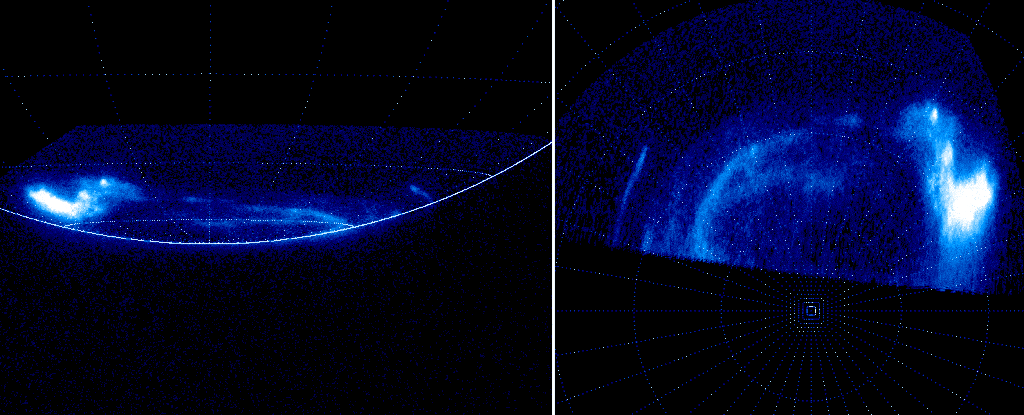
Just as Earth has spectacular auroras, other planets in the solar system have their own versions of the atmospheric light show.
In fact, Jupiter has the most powerful auroras in the solar system – invisible to our eyes, but glowing brilliantly in ultraviolet wavelengths.
Because Jupiter is so vastly different from Earth, scientists are deeply invested in learning these incredible atmospheric phenomena – and they just got a new clue. Thanks to the Juno orbiter, we have now for the first time observed the beginning of Jupiter’s mysterious auroral morning storm.
Jupiter’s auroras are produced by a constant shower of high-energy electrons largely removed from Io’s atmosphere. These are accelerated along magnetic field lines to Jupiter’s poles, where they fall into the upper atmosphere and interact with the gases to produce a glow.
This is in contrast to Earth’s auroras, which are produced by particles from the solar wind. Also unlike Earth’s auroras, Jupiter’s auroras are permanent and can behave very differently.
One of these behaviors is the morning storm – an intense clearing and widening of the aurora at sunrise, first observed in 1994. However, these morning storms start on the night side of the Pole and we could never have seen them form. until NASA’s Juno probe arrived on the scene.
“By observing Jupiter’s aurora from Earth, you cannot see beyond the limb, into the night side of Jupiter’s poles,” explains astronomer Bertrand Bonfond of the University of Liège in Belgium.
“Explorations by other spacecraft – Voyager, Galileo, Cassini – were done from relatively long distances and didn’t fly over the poles, so they couldn’t see the full picture. That’s why Juno’s data is a real game-changer, giving us a better understanding. of what happens on the night side, where the dawn storms are born. “
 The rise of a morning storm. (NASA / JPL-Caltech / SwRI / UVS / ULiège / Bonfond)
The rise of a morning storm. (NASA / JPL-Caltech / SwRI / UVS / ULiège / Bonfond)
Dawn storms are a real thing. They start on the night side of the planet, rotate into view at dawn, and transform Jupiter’s aurora into a blazing ultraviolet beacon, emitting hundreds to thousands of gigawatts of light – at least 10 times more energy than the usual Jupiter aurora. They last for a few hours before declining to more normal energy levels.
Because the two planets have such differences between their auroras, the process that generates the dawn storm was expected to be different from any of the processes seen in Earth’s auroras. Surprisingly, however, the data from Juno’s ultraviolet spectrograph looked strangely familiar.
“Looking at the whole series of morning storms, we couldn’t help but notice that the auroras from the morning storm at Jupiter are very similar to some kind of terrestrial auroras called substorms,” said astronomer Zhonghua Yao of the University of Liège.
Earth’s auroral substorms are astonishing to behold. They occur when the Earth’s magnetosphere is disturbed by electric currents, resulting in an explosive release of energy in the ionosphere. There, the energy is dissipated as a complex dancing aurora that can last several hours.
Substorms are strongly influenced by the solar wind and the orientation of the interplanetary magnetic field. But Earth’s magnetosphere is dominated by interactions with the solar wind; Jupiter’s is filled with plasma stripped of Io, which is controlled by the planet’s location.
According to the team’s analysis, Jupiter’s dawn storms are affected by an excess of Io’s plasma, rather than the solar wind; but the result is the same, a disruption of the magnetosphere resulting in an explosive release of energy.
In either case, an accumulation of plasma and energy gradually increases the instability in the system into a tree-auroral storm.
This can only increase our understanding of the auroral processes on both planets, and could help us better understand auroras on other bodies in the future – including brown dwarfs, which have strong enough auroras to detect in interstellar space, even if they are not near a star.
Although the ‘engine’ of the auroras on Earth and Jupiter is very different, showing for the first time the relationships between the two systems allows us to identify universal phenomena and distinguish them from the particulars pertaining to each planet, Yao said.
“The magnetospheres of Earth and Jupiter store energy through very different mechanisms, but when this accumulation reaches a breaking point, the two systems explosively release this energy in a surprisingly similar way.”
The research is published in AGU advances